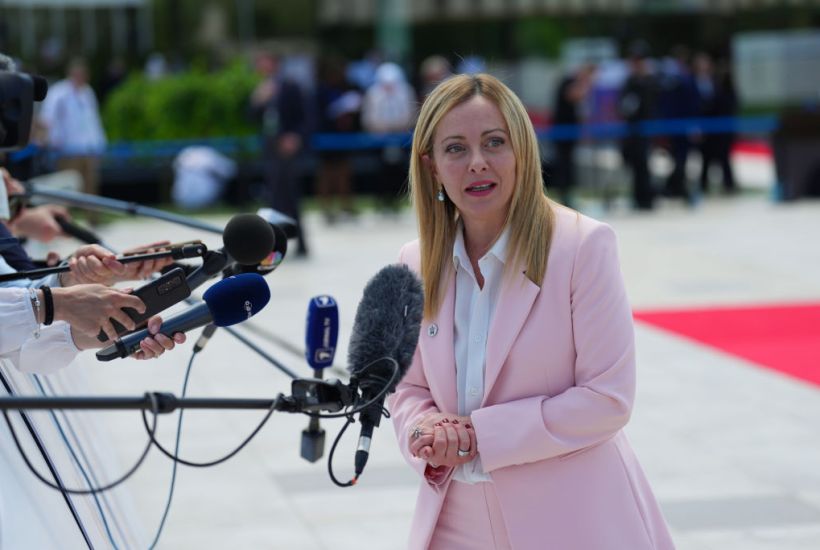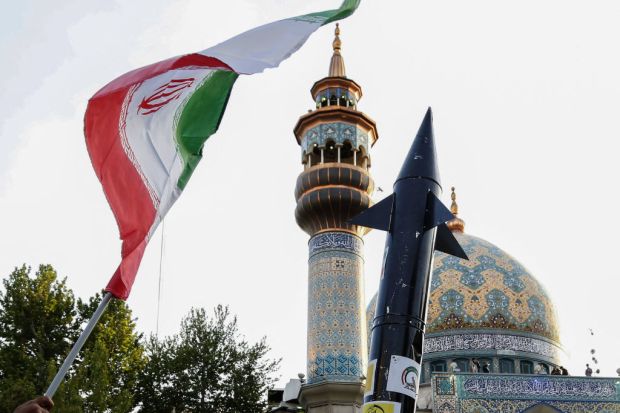Cerberus, the record-breaking heatwave that has struck the Mediterranean, will be followed next week by another one called Charon – after the mythical boatman who ferried the dead across the Styx to Hades. Meanwhile illegal migrants continue to be ferried across the Mediterranean in record numbers to Italy – thus to Europe – by people traffickers. Relatives placed a single obol, it is said, in the mouths of the dead to pay Charon for the voyage. The living pay the traffickers €3,000 to €10,000, it is said, for theirs.
In April, Meloni declared Italy’s migrant crisis a national emergency. So far this year 75,000 illegal migrants have arrived here by boat – more than double the number who arrived in the same period in 2022. This year’s total looks set to exceed the 2016 record of 181,436.
Giorgia Meloni’s left-wing opponents are cock-a-hoop at what they see as proof that Italy’s conservative prime minister is all mouth and no trousers. She is failing to deliver – they crow – on her election campaign pledge last summer to stop the migrant boats. Just as Rishi Sunak in Britain is failing to deliver on his promise to stop migrant boats crossing the Channel.
Would her opponents, who include not just the left but most newspapers and television channels outside Italy, stop the boats? No, of course not. The more migrants the merrier as far as they are concerned. So why aren’t they applauding her, you might ask.
They are just as delighted by her announcement earlier this month that Italy will grant work permits to 450,000 non-EU workers between 2023 and 2025 – roughly 150,000 a year. This is higher than the quotas in recent years, though well below the record 250,000 in 2006.
This relatively high quota is proof – they tell us – that she is a hypocrite who has been forced to accept their narrative which dictates that Italy needs migrants because employers cannot find Italians to work for them, and because fertility rates are in decline with no young people to pay its pensions (since peaking at 60.8 million in 2014, Italy’s population has fallen by 1.7 million).
Actually, contrary to what you might think by reading British newspaper coverage of Italy, Meloni has always been in favour of such quotas.
When I interviewed her during last summer’s election campaign which brought her to power, she told me that Italy does indeed need non-EU workers. Italy ‘needs a quota of migrants’, she said. But ‘the first rule is that no one must enter Italy illegally’.
Precisely. Unlike those who arrive illegally by boat, migrants admitted under Italy’s quota system at least have a passport and a work permit which is temporary not permanent. And to get that permit, an employer in Italy must send them a work contract in their country of origin. Only then, will they be able to get a visa to travel to Italy – which they can only get from the Italian consulate in their own country. Under a new rule, employers can only employ a non-EU worker if they are unable to find an Italian for the job – except in the case of seasonal workers. And applicants from countries with which Italy has signed agreements to hinder the trafficking of illegal migrants get preference.
Italy’s quota system is of course open to serious abuse. It is commonly believed, for instance, that a large percentage of non-EU quota workers are already in Italy, where there are believed to be about 500,000 illegal migrants. And that a large number of the employers offering contracts under the quota system are immigrants and the contracts themselves bogus.
Italy does need a certain number of migrant workers from outside the EU, especially seasonal workers in sectors such as agriculture and tourism. But it cannot be true that it needs huge numbers across the board. Nearly all work quota migrants – just like the ones who arrive illegally by boat – are young men. Yet Italy’s youth unemployment rate is 25 per cent and as high as 50 per cent in much of the poor south.
Migrants also place pressure on schools, housing and the health service. As for the economic consequences, even the Office for Economic Co-operation and Development (OECD) is sceptical. An OECD report concludes: ‘There is little doubt that where migration expands the workforce, aggregate GDP can be expected to grow. However, the situation is less clear when it comes to per capita GDP growth… An increase of 50 per cent in net migration of the foreign-born generates less than one tenth of a percentage-point variation in productivity growth.’
And the only reason Italy needs so many seasonal workers is because most Italians refuse to accept the pitiful wages employers get away with thanks to the availability of migrants. Ironically, it is capitalists and their ruthless greed rather than the no borders left who are mostly to blame for Europe’s migrant crisis. That makes it so much more difficult for right-wing governments to tackle the crisis. And it explains why in the 1960s and 1970s the left was as hostile to mass immigration as the right.
But nor does the idea stand up to scrutiny that the only way to solve Italy’s demographic crisis is to open the gates to huge numbers of migrants. As Meloni told me: ‘It won’t help if they’re nearly all men!’
Meloni’s aim is to persuade Italian women to have more babies. But sadly, it is probably harder to do this than to solve the migrant crisis. Italy’s fertility rate is 1.24 which is way below the replacement level of 2.1. She is considering, among other things, the abolition of income tax for families with three or more children.
But to put the size of her 450,000 non-EU workers quota into perspective, in 2022 Italy’s net migration (the difference between those who legally emigrated and immigrated) was 228,816 compared to Britain’s 600,000. Whereas 360,685 legal immigrants came to Italy last year, 1.2 million came to Britain.
Italy’s immediate problem is illegal immigration. Meloni is using the migrant work quota system as a bargaining chip with countries such as Libya and Tunisia in order to secure their help in trying to stop the flow of illegal migrants.
For more than a decade Libya has been the main departure point for the people trafficker boats even though it is 300 miles from Sicily. But this year Tunisia – far closer – has taken over.
Since becoming Italy’s first female prime minister Meloni has devoted much of her energy to trying to persuade Tunisian president Kais Saied to stop the boats. Saied was elected in 2019, but with Tunisia on the verge of bankruptcy, suspended democracy in 2021 and rules by decree.
In March, Meloni warned EU leaders at a European Council summit that ‘if Tunisia collapses’ Italy risks the arrival by sea of 900,000 migrants from Tunisia. Italy’s secret services warn of a further 685,000 migrants ready to cross to Italy from Libya.
Meloni has tried hard to convince reluctant EU leaders that all member states must share the defence of the EU’s common external borders and share out the migrants who arrive – but with only mixed success. She is also adamant that the EU must convince African countries to allow the EU to process asylum applications in those countries. For once migrants reach Italy – and Europe – it is virtually impossible to send them home. Italy actually physically deports only 5,000 migrants a year.
Meloni’s main goal has been to convince her EU partners to fork out a similar bribe to the €6 billion EU one, orchestrated by then German chancellor Angel Merkel, to president Recep Erdogan in 2016 to stop refugees departing from Turkey for Greece. Many of those stopped from departing from Turkey were genuine refugees, above all from Syria. In Italy’s case, however, most are economic migrants.
In June, Meloni met Tunisia’s president Saied twice in an attempt to stop the boats – the second time she was accompanied by EU Commission president Ursula Von der Leyen.
Von der Leyen’s presence was a clear sign that Meloni was making progress with her EU partners. As was the EU Commission president’s pledge to Saied that the EU will give his crisis torn country €1 billion in aid. That pledge appears to have paid off. On Sunday, Tunisia and the European Union agreed a ‘strategic partnership’ deal, which will see the bloc give €100 million to Tunisia to help it combat illegal migration. ‘We are very pleased, it is a further important step towards creation of a true partnership between Tunisia and the EU, which can address in an integrated fashion the migration crisis,’ Meloni said after the deal had been agreed.
In Libya, Italy has since 2016 equipped and trained with some success the Libyan coastguard to stop and take back migrant boats – it returned nearly 25,000 migrants to Libya in 2022. Meloni has visited Libya to talk about oil, gas and migrants and in June its prime minister, Abdul Hamid Dbeibeh, was in Rome to meet her.
Before coming to power Meloni often used to say that she would impose a naval blockade of Libya to stop the migrants. Her opponents taunt her constantly about this as well, insisting that it is yet another example of her supposedly far right, fascist psyche.
Such a blockade would of course be impossible given the length of Libya’s coast – not to mention Tunisia’s – but the Libyan coastguard is already performing that role to a limited extent. And guess who introduced the programme to train and equip the Libyan coastguard back in 2016? Why yes, the left-wing Italian government of Matteo Renzi who was Barack Obama’s favourite European. Italy faces its hottest summer ever for both temperature and migration. But the biggest hypocrites of all are Meloni’s opponents – not her.
Got something to add? Join the discussion and comment below.
Get 10 issues for just $10
Subscribe to The Spectator Australia today for the next 10 magazine issues, plus full online access, for just $10.



















Comments
Don't miss out
Join the conversation with other Spectator Australia readers. Subscribe to leave a comment.
SUBSCRIBEAlready a subscriber? Log in